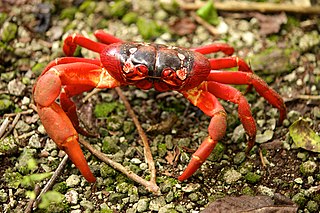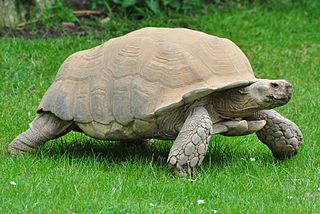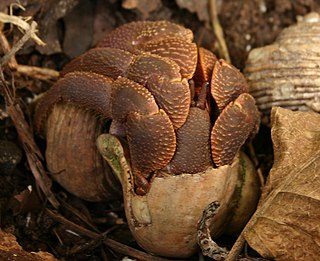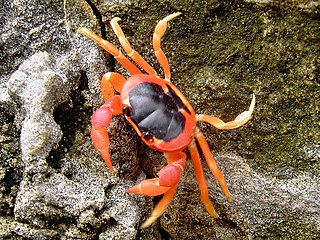
Ghost crabs are semiterrestrial crabs of the subfamily Ocypodinae. They are common shore crabs in tropical and subtropical regions throughout the world, inhabiting deep burrows in the intertidal zone. They are generalist scavengers and predators of small animals. The name "ghost crab" derives from their nocturnality and their generally pale coloration. They are also sometimes called sand crabs, though the name refers to various other crabs that do not belong to the subfamily.

The Christmas Island red crab is a species of land crab that is endemic to Christmas Island and Cocos (Keeling) Islands in the Indian Ocean. Although restricted to a relatively small area, an estimated 43.7 million adult red crabs once lived on Christmas Island alone, but the accidental introduction of the yellow crazy ant is believed to have killed about 10–15 million of these in recent years. Christmas Island red crabs make an annual mass migration to the sea to lay their eggs in the ocean. Although its population is under great assault by the ants, as of 2020 the red crab had not been assessed by the International Union for Conservation of Nature (IUCN) and it was not listed on their Red List. The crab's annual mass migration to the sea for spawning is described as an "epic" event. Millions emerge at the same time, halting road traffic and covering the ground in a thick carpet of crabs.

Cancer pagurus, commonly known as the edible crab or brown crab, is a species of crab found in the North Sea, North Atlantic Ocean, and perhaps the Mediterranean Sea. It is a robust crab of a reddish-brown colour, having an oval carapace with a characteristic "pie crust" edge and black tips to the claws. A mature adult may have a carapace width up to 25 centimetres and weigh up to 3 kilograms. C. pagurus is a nocturnal predator, targeting a range of molluscs and crustaceans. It is the subject of the largest crab fishery in Western Europe, centred on the coasts of the British Isles, with more than 60,000 tonnes caught annually.

The African spurred tortoise, also called the sulcata tortoise, is an endangered species of tortoise inhabiting the southern edge of the Sahara Desert, the Sahel, in Africa. It is the largest mainland species of tortoise in Africa, and the third-largest in the world, after the Galapagos tortoise and Aldabra giant tortoise. It is the only living species in its genus, Centrochelys.

The leopard tortoise is a large and attractively marked tortoise found in the savannas of eastern and southern Africa, from Sudan to the southern Cape Province. It is the only extant member of the genus Stigmochelys, although in the past, it was commonly placed in Geochelone. This tortoise is a grazing species that favors semiarid, thorny to grassland habitats. In both very hot and very cold weather, it may dwell in abandoned fox, jackal, or aardvark burrows. The leopard tortoise does not dig other than to make nests in which to lay eggs. Given its propensity for grassland habitats, it grazes extensively upon mixed grasses. It also favors succulents and thistles.

The red-footed tortoise is a species of tortoise from northern South America. These medium-sized tortoises generally average 30 cm (12 in) as adults, but can reach over 40 cm (16 in). They have dark-colored, “loaf”-shaped carapaces with a lighter patch in the middle of each scute, and a somewhat lighter-colored plastron (underbelly). They also have dark limbs dotted with brightly-colored scales, from which they get their name, that range from pale yellow to vivid or dark red. Visible differences are noted between red-footed tortoises from varying eco-regions. They are closely related to the more easterly-distributed yellow-footed tortoise of the Amazon Basin.

Gecarcinus quadratus, known as the red land crab, whitespot crab, Halloween crab, moon crab, Halloween moon crab, mouthless crab, or harlequin land crab, is a colourful land crab from the family Gecarcinidae.

Coenobita brevimanus is a species of terrestrial hermit crab belonging to the family Coenobitidae, which is composed of coastal living terrestrial hermit crabs. From there it belongs to the genus Coenobita, one of two genera split from the family, which contains sixteen species. The Latin origins of the species name, brevimanus, come from the adjective brevis ("small") and the noun manus ("hands"). It is known as the Indos crab or Indonesian crab because it is primarily distributed throughout the Indo-Pacific.

The Gecarcinidae, the land crabs, are a family of true crabs that are adapted for terrestrial existence. Similar to all other crabs, land crabs possess a series of gills. In addition, the part of the carapace covering the gills is inflated and equipped with blood vessels. These organs extract oxygen from the air, analogous to the vertebrate lungs. Adult land crabs are terrestrial, but visit the sea periodically, where they breed and their larvae develop. Land crabs are tropical omnivores which sometimes cause considerable damage to crops. Most land crabs have one of their claws larger than the other.

Cardisoma guanhumi, also known as the blue land crab or great land crab, is a species of land crab found in tropical and subtropical estuaries and other maritime areas of land along the Atlantic coast of the Americas from Brazil and Colombia, through the Caribbean and Gulf of Mexico, to the Bahamas, and north to Ponce Inlet, Florida Princess Place Preserve on the Palm Coast, and Bermuda. The species varies in colour from dark blue to brown or pale grey, and may grow to 15 centimetres (6 in) in carapace width and weigh over 500 grams (18 oz).

Cardisoma is a genus of large land crabs. Three species formerly placed in this genus are now placed in Discoplax. The four species that remain in Cardisoma are found in warm coastal regions where they live in burrows. Young individuals are often very colourful with a purple-blue carapace and orange-red legs, but as they grow older the colours tend to fade, and females may be duller than males. Although less extreme than in fiddler crabs, one claw is usually considerably larger than the other. They are omnivores, but primarily feed on plant material.
Moon crab can refer to several crab taxa:

Gecarcinus lateralis, also known by the common names blackback land crab, Bermuda land crab, red land crab and moon crab, is a colourful crab from the family Gecarcinidae.

The coconut crab is a terrestrial species of giant hermit crab, and is also known as the robber crab or palm thief. It is the largest terrestrial arthropod known, with a weight of up to 4.1 kg (9 lb). The distance from the tip of one leg to the tip of another can be as wide as 1 m. It is found on islands across the Indian and Pacific Oceans, as far east as the Gambier Islands, Pitcairn Islands and Caroline Island and as far west as Zanzibar. While its range broadly shadows the distribution of the coconut palm, the coconut crab has been extirpated from most areas with a significant human population such as mainland Australia and Madagascar.

Gecarcinus ruricola is a species of terrestrial crab. It is the most terrestrial of the Caribbean land crabs, and is found from western Cuba across the Antilles as far east as Barbados. Common names for G. ruricola include the purple land crab, black land crab, red land crab, and zombie crab.

Eudicella gralli, sometimes called the flamboyant flower beetle or striped love beetle, is a brightly coloured member of the scarab beetle family, in the subfamily known as flower beetles. Their shells seem to have a prismatic quality, refracting the ambient light to give the green of their carapace a rainbow tint. This species of flower beetle lives in the rainforests of Africa, where it feeds on the nectar and pollen of flowers, but is popular in the exotic pet trade. The larvae of the flower beetle live in decaying wood, feeding on dead wood and leaf litter. Adults reach lengths of 25–40 millimetres (0.98–1.57 in). As in other species of this genus, the males have a Y-shaped horn, used to fight over females. The females have a shovel-like tusk, used for burrowing in wood. During their gestation period they will dig into the wood and lay eggs.

Mictyris longicarpus, the light-blue soldier crab, is a species of crab that lives on sandy beaches from the Bay of Bengal to Australia; with other members of the genus Mictyris, it is "one of the most loved crabs in Australia". Adults are 25 mm (1 in) across, white, with blue on their backs, and hold their claws vertically. They feed on detritus in the sand, leaving rounded pellets of discarded sand behind them. The males may form into large "armies" which traverse the beach at low tide, before the crabs dig into the sand to wait for the next low tide.

Ocypode gaudichaudii, also known as the painted ghost crab or cart driver crab, is a species of crab found on Pacific beaches from El Salvador to Chile as well as on the Galápagos Islands. The species was first described by Henri Milne-Edwards and Hippolyte Lucas in 1843.

Crustaceans may pass through a number of larval and immature stages between hatching from their eggs and reaching their adult form. Each of the stages is separated by a moult, in which the hard exoskeleton is shed to allow the animal to grow. The larvae of crustaceans often bear little resemblance to the adult, and there are still cases where it is not known what larvae will grow into what adults. This is especially true of crustaceans which live as benthic adults, more-so than where the larvae are planktonic, and thereby easily caught.

Red Devil Vampire Crabs are decapod crustaceans part of Brachyura.





















